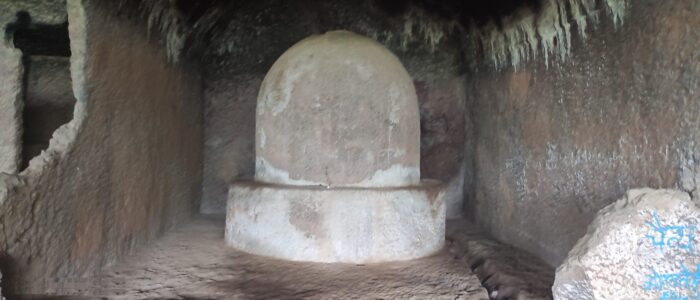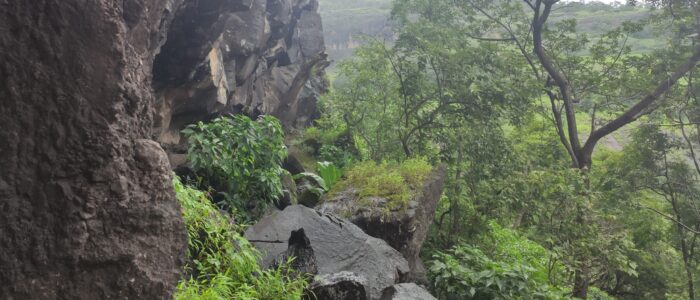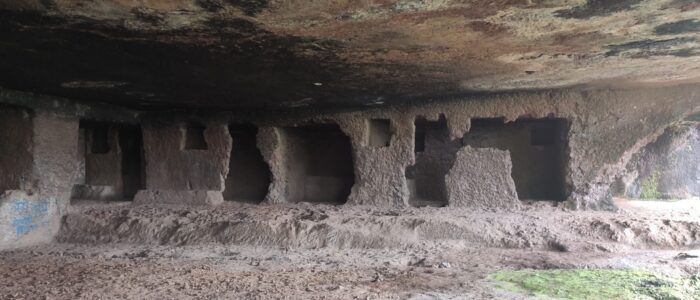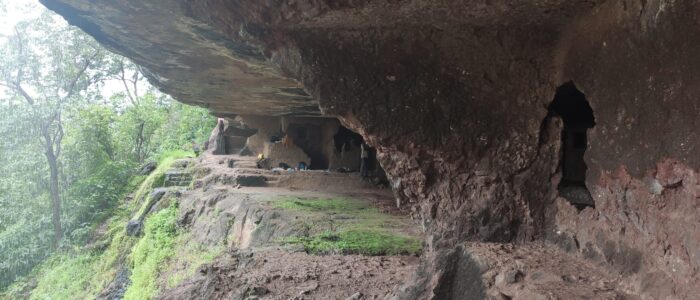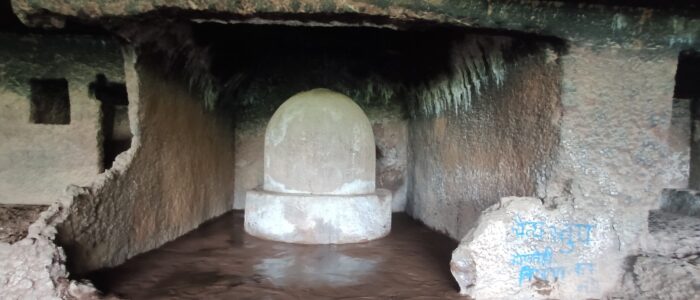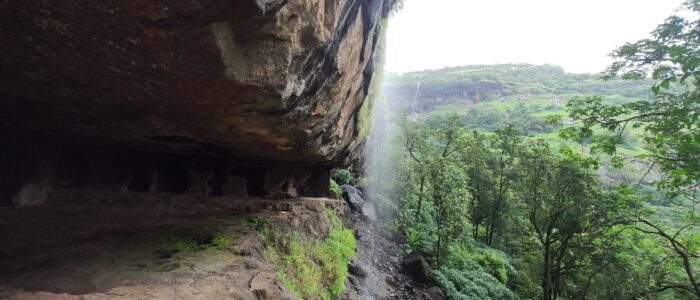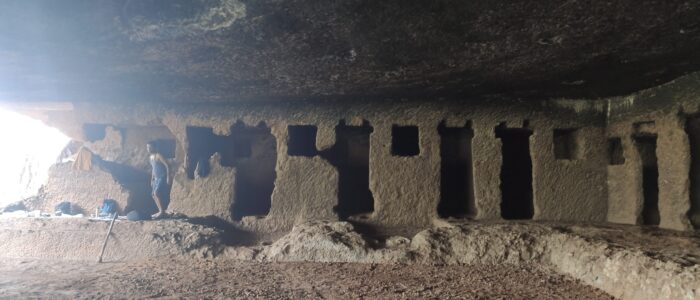Nenavali Caves
are also known as Khadsambale Caves. These caves are situated near Nenavali village, located at Sudhagad at Raigad, India. This is a group of 40 Buddhist caves about 35 km from Pali.
Location:
These caves are situated near Nenavali village, that is why they called Nenavali Caves. They are situated in a spur running out from the main chain of the Ghats in a southwest direction, south of the hill fort of Borapgadh, hardly two miles east of the village of Khadsamble, and about six miles south of the Nadsur/Thanale Caves.
Description:
The Nenavali Buddhist Caves are a very large group of 40 caves.
Actually, there are about 30 to 48 caves in the area, but it is difficult to say exactly how many caves there are now, as many caves have been buried. Almost all the entrances to the caves have been destroyed. These caves are carved in a single stone.
The rock of this cave is a reddish brown stone and is not very durable so these caves have been severely damaged.
History:
These caves are on the ancient Buddhist trade route. The caves were discovered in 1889 by Reverend Abbott. These caves were carved in the 2nd century BC.
Cave Architecture:
Cave No. 1 is a partial cave as most of the portions have been destroyed.
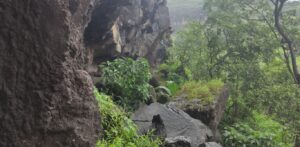
Cave No. 2, you can only recognize the back wall of cave number two, the rest of the galaxy in front of it has been destroyed.
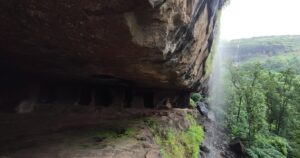
Cave No. 3, from the remnants of number three, there is a Shunyagar for meditation purposes and a hall in front.
Cave No. 4, in this cave number four, you can see the remnants of the wall sticking to the roof. Besides, the walls have completely collapsed and the front view has been destroyed.
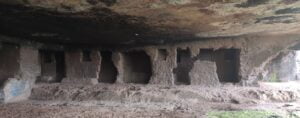
Cave No. 5 is the same and you can see the sleeping platform on the back wall.
Cave No. 6 is the only room you can recognize and there is a niche in the back wall of the room.
Cave No. 7 is in the same condition, the back room can be identified and all the others are in a broken state, the facades of the caves have been destroyed, the roof remains and today they are witnessing those caves.
Cave No. 8 is magnificent and its configuration is typical. One can enter the galaxy in front by climbing three steps from the courtyard. There is a hall on the side of the galaxy on the right side of the hall there is a distance hall, and there is a room in the center. The square window on the front wall of the interior hall having a platform to the right of the interior hall. Overall, the layout of these caves makes them look like a multi-room flat. There are a total of five platforms in this cave.
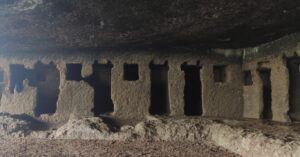
Cave No. 9 has a ceiling balance and the back room and the back wall have one platform.
Cave No. 10 consists of one large vihara 67 feet 9 inches wide by about 52 feet in depth, with a number of smaller subsidiary excavations in ruins upon either side of it.
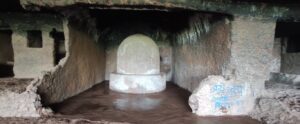
There are 17 cells surround the three sides of the principal cave; and the dagoba shrine, which is very slightly larger than No. 8 at Nadsur/Thanale Caves, is here included in the larger vihara, and forms part of it, it being excavated still further in off the back wall. Like the Thanale Caves, the whole of the fronts of these caves has fallen away.
Around the three sides of the large cave are seventeen cells, each provided with its bench, and all having once held wooden door-frames and doors. The windows of the cells, which are high off the ground, are here all quite open and are not filled with grating or crossbars as those at Thanale are.
The dagoba shrine, which at Thanale is excavated beside the main vihara, is here part of it, a portion of the back wall at the east end being driven further in to form the vaulted compartment, 15 feet 6 inches high, in the middle of which stands a dagoba 11 feet in diameter and. 10 feet 10 inches high. In the top of the dagoba, which has no Tee, are five holes, one central square one, and four circular ones forming a square around it. In each of the cells in the back wall is a little cupboard niche. As in the Thanale Cave 7, the main cave here has the bench around it, broader on one side where, from slots in the ceiling, it would appear to have been screened off in the same manner. The caves appear to have been plastered.
There are caves 11 to 21 beside it. They are in a dilapidated condition. The spacious side of the cave has been damaged due to the collapse of the cliffs.
You can see a total of 42 platforms that are carved for the sleeping of the monks. There must have been about 70 monks sleeping here.
There is a group of caves on the other side of the ridge which is the same but it is divided due to the breakage of the ridge.
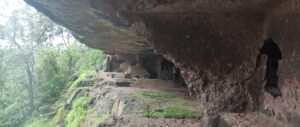
There is a total absence of all sculpture and ornament, and no inscriptions could be found, but the great likeness of this cave and its subsidiary ones to those at Thanale leaves no possible doubt as to there having been excavated by the same people at the same time. Like those at Thanale, too, the water cisterns are dry, and the same layer of soft red rock runs through them. The minor caves on either side of the large vihara are insignificant and in ruin. Among them may be noticed a few small roughly cut shrines containing rock dagobas.
Nenavali Cave Deterioration
As is the unfortunate case with most of our Caves, the following are the main reasons why Nenavali is getting destroyed day by day:
• The cave was completely destroyed by the earthquake. The entire caves have been buried under these rocks due to the collapse of the front.
• As there is a waterfall in front of the caves, the water particles are eroding the rocks.
• The inside of the cave is getting eroded and brittle due to wind and rain.
• Human Interference graffiti, carelessness, etc, which is unfortunately seen at all our archaeological sites.
Transportation Information:
Nearest Airport: Mumbai
Nearest Railway Station: Khopoli Railway Station
Nearest Bus Station: Nenavali Bus Stop
Coordinates: 18.506954°N 73.335075°E
Map:
Committed to research & conservation of Buddhist monuments that have a historical heritage of India.
